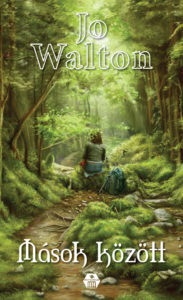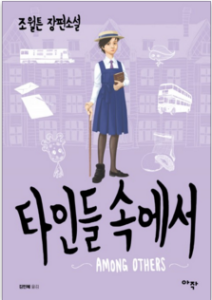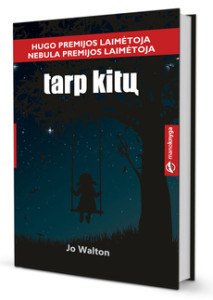Most of my books get titles early in the process, thematically. Sometimes the title is one of the first things I know about a book — this was the case for Farthing, and Tooth and Claw and My Real Children. Other times the thematic title will come along a few chapters in — this was the case with The King’s Peace. With Among Others I wrote the entire book without having a title, and I didn’t have a title for months afterwards, and when I did have a title it was thought up by my friend Rene Walling and not by me. The problem was that I had a title — it was just the wrong title. That wrong title was “The Industrial Landscape of Elfland”, which was the perfect title for the original blog post that sparked the book, but not for the book as it came out. I thought of calling it all kinds of things — “Deep They Delved Us” and “Night’s Plutonian Shore” (I really liked that one for its blend of SF and fantasy, but PNH said it sounded like a book about a domed colony on Pluto) and “Reading in the Dark” and “Fairies and Librarians”. Pretty much as soon as Rene suggested “Among Others” it became the canonical title and I’d find it hard to think of the book as anything else.
Except of course that it’s also Extra Extranos and In Ein Anderen Welt and Morwenna and so on. Lots of the foreign titles are straight translations. Others aren’t. I thought it might be interesting to take a look at the other titles and covers the book has had. For the people who live in those counties and read the translations, this is their “real” version. The translator changes every word I wrote for a different word, and this must be a hard book to translate.
So what can we learn from the choices of titles? Most of the titles are straight translations, and when they can’t be that some are “Among Strangers” or “Among Foreigners”. The German is “In Another World” and the Italian “Another World”. The French went with Morwenna. which is something I’d never have considered.
As for covers, let’s just look at them all together and on the understanding that these are all the same book, if not quite the book I wrote. I will add more as I have more.
The original US cover — too orange, too girly. It doesn’t look like a book I’d want to read. (But what do I know?) The figure has no head and she’s standing unsupported. The fairies are represented by a swirl of sparkly lights — take note of that, it’s going to be a recurring feature, even though it’s not at all the way the fairies are described in the text. The sparkly lights symbol starts on this cover. The landscape is rural, not post-industrial. The character looks about the right age. This cover was the first, and became the template for several other covers.
The UK cover — clearly a “translation” or reinterpretation of the US cover. The figure has a head but no face, and she’s still standing unsupported. The fairies are again a swirl of lights, and the landscape is again rural. She looks older than 15 to me, but it’s hard to tell because she’s so indistinct. I like the colours better, and that’s a great font for the title.
The large print edition cover. I hate this. It’s hard to explain why. It’s mostly because it does everything semiotically to convey that it is the kind of book that it so very much isn’t — it’s pastoral and romantic. Ick. My least favourite cover. Also, no cane. It has been suggested that these covers where she has no cane are meant to be representing Mor, the dead twin, that what we’re seeing is the ghost. This one is the most convincing for that. But I still hate it. If covers are supposed to be a “mini billboard” advertising the book, then I think this one is false advertising. if you picked this up wanting the book it promises, you’d be disappointed by the real book. Also it would put off people who would like it. Sorry, large print readers.
The French cover — another “translation” of the US cover image. Sepia this time, perhaps to evoke the past — though I swear we had colour photography in 1979! Same swirl of lights for fairies, very rural landscape, and she’s positively skipping along. She looks much younger than 15 to me. She’s facing away from the reader, unlike in the US and UK covers. This means she has a head but still no face. She’s wearing a summer dress and has bare arms and long loose fair hair — very much not the way the character is described. And the title is — Morwenna, the character’s name, an interesting choice. Again no cane, and maybe this is supposed to be earlier?
Then there’s the French pocket book cover, completely different, not related in any way to any of the other covers, and I like it a lot. The magic library is great, and evocative, even if it isn’t in the actual text. And she has a cane, and she’s wearing jeans, and she looks the right age, and she has a head and she’s even facing towards us not away. Again it has the glow of light representing fairies or magic or something, echoing the US cover. I’d pick up this book, and I’d expect it to be a fantasy book featuring libraries and a fifteen year old girl with a cane and something magic, which tells me that this is doing everything right. Unfortunately, it has a huge grey obi that says things about awards and hides most of the cover.
The Polish cover — my favourite “translation” of this image. Clearly this was inspired by the US cover, but I like it very much more. She has a visible cane, yay, and a much more interesting idea of fairies, that roiling sky looks almost science fictional. I also like the colours. She’s facing away from the reader and so has no face, but she does have a head. She’s wearing a dress, though it could be a school uniform dress. She definitely looks fifteen, not like a little kid or an adult. And the title means “Among Strangers”.
The Croatian cover keeps ths swirl of lights, but is otherwise entirely different. This is another one I really like, even though it isn’t an illustration of the text. The hand and the reflection is an interesting way of dealing with the twin issue, and there actually is a pool of water in the book, even if nobody kneels beside it and trails a finger. I also think this is a striking image. I’d pick this one up for sure. The red thing definitely evokes a dress, and she doesn’t have a head, and I can’t tell how old she is. The title means “Among Foreigners”. Also I love the font they used for my name. Great J. Great swirl on the LT of “Walton”.
 This is the Turkish cover — I like it. It’s a completely different feel, with the trees and the light and no people at all. It’s very very rural, but there’s a clearly man-made path through the wood. This is a cover that would make me want to pick up the book. There are trees and paths through them in the text, and it looks kind of magical. And it’s the start of a new trend in covers! Look at that green leafy feel with a tunnel path.
This is the Turkish cover — I like it. It’s a completely different feel, with the trees and the light and no people at all. It’s very very rural, but there’s a clearly man-made path through the wood. This is a cover that would make me want to pick up the book. There are trees and paths through them in the text, and it looks kind of magical. And it’s the start of a new trend in covers! Look at that green leafy feel with a tunnel path.
 And here’s the Romanian cover — a “translation” of the Turkish image! Isn’t that interesting? It isn’t until you see them together that you can see how close they are. The Turkish one came out years before the Romanian one, so the influence definitely went in that direction. I wonder if the Romanian cover artist looked at this page, because otherwise where would they have seen it? Though maybe Turkish books are common in Romania. A Turkish friend of mine went to a con in Romania, so what do I know. The title means “Among Others” and I think this cover is great, I might well pick it up.
And here’s the Romanian cover — a “translation” of the Turkish image! Isn’t that interesting? It isn’t until you see them together that you can see how close they are. The Turkish one came out years before the Romanian one, so the influence definitely went in that direction. I wonder if the Romanian cover artist looked at this page, because otherwise where would they have seen it? Though maybe Turkish books are common in Romania. A Turkish friend of mine went to a con in Romania, so what do I know. The title means “Among Others” and I think this cover is great, I might well pick it up.
 Now here’s the Hungarian cover. This one is great. Another favourite. More trees, as featured in the book, another tunnel path through them as seen on the Turkish cover, but there she is among them, sitting down, with a backpack (no doubt full of books) and fairly unobtrusively but actually there, a walking stick! And she’s wearing jeans, exactly as described in the book. Many of these other covers that feature Mori show her in clothes far more girly than she ever wears in the text. Some (like the Polish and Korean covers) are school uniform, which does have a skirt, but others have made the choice to feminize her clothes. Also, when I was thinking about describing it, I was going to say “There are no fairies in this image” and then I had to check to make sure. I love that. Can you be absolutely sure there isn’t anything there?That’s very evocative of the actual book. She’s facing away, but then that’s the fashion. And this is a cover I’d definitely pick up if I saw it on a shelf in a bookstore. So this makes me happy. The title is a straight translation as far as Google knows. Go Hungarians, they also gave me a great cover for Farthing.
Now here’s the Hungarian cover. This one is great. Another favourite. More trees, as featured in the book, another tunnel path through them as seen on the Turkish cover, but there she is among them, sitting down, with a backpack (no doubt full of books) and fairly unobtrusively but actually there, a walking stick! And she’s wearing jeans, exactly as described in the book. Many of these other covers that feature Mori show her in clothes far more girly than she ever wears in the text. Some (like the Polish and Korean covers) are school uniform, which does have a skirt, but others have made the choice to feminize her clothes. Also, when I was thinking about describing it, I was going to say “There are no fairies in this image” and then I had to check to make sure. I love that. Can you be absolutely sure there isn’t anything there?That’s very evocative of the actual book. She’s facing away, but then that’s the fashion. And this is a cover I’d definitely pick up if I saw it on a shelf in a bookstore. So this makes me happy. The title is a straight translation as far as Google knows. Go Hungarians, they also gave me a great cover for Farthing.
The Serbian cover — one of very few where the girl has a face! An industrial background, and lightning. There’s no cane, but she’s sitting down. This looks like a cover drawn by somebody who read the book and thought about it, not by somebody looking at the original cover or any of the other covers. The title is a straight translation. They also transliterated my name, which is kind of cool. Dzo Volton is my secret Ninja name.
The Chinese cover — a face, light through trees, a headscarf — completely different, and I really like it. I’d pick up this book, it’s intriguing to me. You can’t tell unless you look at it full size, but the regular white bits on the lower part of the cover are text, and the more scattered ones above are little lights, which I think is very appropriate. The title means “I do not belong to them” which is a pretty good translation of one of the primary things “Among Others” means. Also, the twin names are Mo Weina and Mo Gana, like actual Chinese names, and there’s interesting use of the forms of “older sister” and “younger sister” that Chinese requires.
The Japanese edition came out in two volumes, giving me two covers to consider. They are completely different from all the others, reflecting an entirely different set of choices about the book. On the right, volume one, it’s clearly meant to be the school, which doesn’t otherwise feature. It took me a while to see this, but the school looks exactly like the way the school really looks, which I didn’t actually describe much in the book, but it just looked right to me, with the gothicy windows and the door like a devouring maw. Really, this is a great image of the school. It’s set in a flat green landscape rather than trying to evoke a pastoral. The figure has a cane (yay!) and appears to be actually using it, but she has no head. She’s wearing what is clearly a school uniform coat. On volume 2 there are headless children holding hands and a pastoral flowerscape. The title means “Magic of the Library” which is a great title, that’s one of the titles I wanted to give it in the first place. There’s no sign of anything on either cover to represent the fact it’s fantasy, it could be an entirely mundane boarding school book. But I am informed that boarding schools seem inherently magical in Japan. Interesting colour schemes. These are two little paperbacks, very cute.
This is the Korean cover, very spiffy. She has a face! And a cane! And a cripple-shoe, as described, and a school uniform as described — that’s exactly what they wore, though that’s the summer hat, not the winter hat, but I don’t think I described the hat at all. That could have been drawn from the actual uniform list from the actual school, which is quite an achievement. And she’s clutching a book. This is great. I also like the general design, the white silhouettes of things against the school. You could say there’s no fairies in this cover, but in fact the general design represents the way the magic system works, the significance of things, which is incredible. This is one of the best covers and I am very very happy with it.
The Spanish cover — the title means “Among Strangers”. Female figure… in the sea. Half a head, no fairies, facing towards the reader. It looks very Gothic. Maybe it’s a random cover? I don’t even…
The Lithuanian cover — title is a straight translation. A little girl on a swing, much younger looking that fifteen, in silhouette. It looks like a children’s horror book to me. But maybe to a Lithuanian audience, this is just right.
The German cover — the title means “In Another World” which is odd, as the book takes places entirely in this world. I love the cover though. I love the text in the background, evoking the diary nature of the book, and the little additions, the flower and so on, which are things in the book. This is another favourite.
And then there’s the German pocketbook cover, with autumnal trees (as in the book) and a scarf, and sparkly fairies in a tranalation of the US cover, and she doesn’t have a visible cane but you can’t see one hand, so she could have one, and she has a coat like a sensible person. She looks older than fifteen, though.
The Italian cover — the title is “Another World”.I’ve actually read chunks of this and it seems well translated to me. But the cover — it’s a lovely colour. Is that butterfly supposed to be a fairy? Or is it symbolic? Or completely random? Beats me. My husband thought this was a cover for My Real Children.
 The Russian cover is very interesting. It’s utterly unlike all the others, essentially no commonality at all. But it’s somehow much closer to the way I imagined the cover would be before it had a cover at all. Books, and a girl with a face — even if it is hidden behind some magic stuff. And the colour palette is sort of what I imagined. She’s also wearing the right uniform. This looks like a cover to the book I wrote. Also, note the Cyrillic spelling of “Jo”.
The Russian cover is very interesting. It’s utterly unlike all the others, essentially no commonality at all. But it’s somehow much closer to the way I imagined the cover would be before it had a cover at all. Books, and a girl with a face — even if it is hidden behind some magic stuff. And the colour palette is sort of what I imagined. She’s also wearing the right uniform. This looks like a cover to the book I wrote. Also, note the Cyrillic spelling of “Jo”.




















